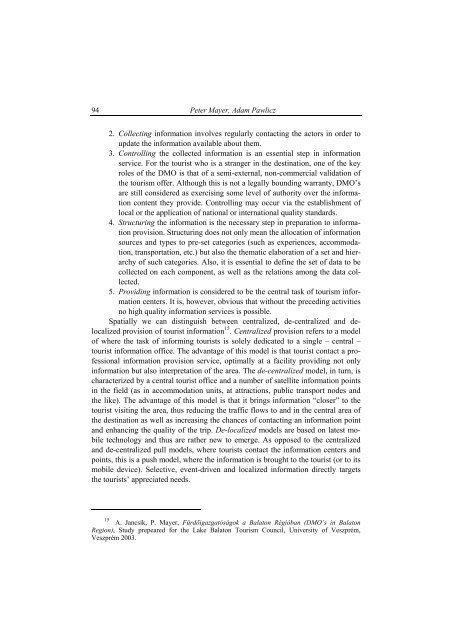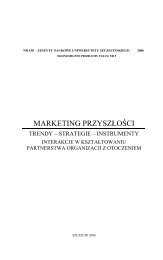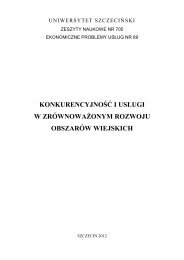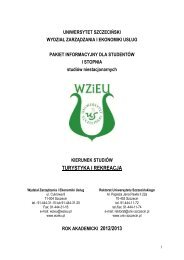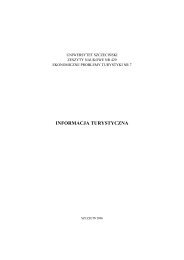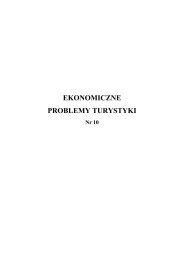Zeszyt naukowy - caÅoÅÄ - WydziaÅ ZarzÄ dzania i Ekonomiki UsÅug
Zeszyt naukowy - caÅoÅÄ - WydziaÅ ZarzÄ dzania i Ekonomiki UsÅug
Zeszyt naukowy - caÅoÅÄ - WydziaÅ ZarzÄ dzania i Ekonomiki UsÅug
Create successful ePaper yourself
Turn your PDF publications into a flip-book with our unique Google optimized e-Paper software.
94<br />
Peter Mayer, Adam Pawlicz<br />
2. Collecting information involves regularly contacting the actors in order to<br />
update the information available about them.<br />
3. Controlling the collected information is an essential step in information<br />
service. For the tourist who is a stranger in the destination, one of the key<br />
roles of the DMO is that of a semi-external, non-commercial validation of<br />
the tourism offer. Although this is not a legally bounding warranty, DMO’s<br />
are still considered as exercising some level of authority over the information<br />
content they provide. Controlling may occur via the establishment of<br />
local or the application of national or international quality standards.<br />
4. Structuring the information is the necessary step in preparation to information<br />
provision. Structuring does not only mean the allocation of information<br />
sources and types to pre-set categories (such as experiences, accommodation,<br />
transportation, etc.) but also the thematic elaboration of a set and hierarchy<br />
of such categories. Also, it is essential to define the set of data to be<br />
collected on each component, as well as the relations among the data collected.<br />
5. Providing information is considered to be the central task of tourism information<br />
centers. It is, however, obvious that without the preceding activities<br />
no high quality information services is possible.<br />
Spatially we can distinguish between centralized, de-centralized and delocalized<br />
provision of tourist information 15 . Centralized provision refers to a model<br />
of where the task of informing tourists is solely dedicated to a single – central –<br />
tourist information office. The advantage of this model is that tourist contact a professional<br />
information provision service, optimally at a facility providing not only<br />
information but also interpretation of the area. The de-centralized model, in turn, is<br />
characterized by a central tourist office and a number of satellite information points<br />
in the field (as in accommodation units, at attractions, public transport nodes and<br />
the like). The advantage of this model is that it brings information “closer” to the<br />
tourist visiting the area, thus reducing the traffic flows to and in the central area of<br />
the destination as well as increasing the chances of contacting an information point<br />
and enhancing the quality of the trip. De-localized models are based on latest mobile<br />
technology and thus are rather new to emerge. As opposed to the centralized<br />
and de-centralized pull models, where tourists contact the information centers and<br />
points, this is a push model, where the information is brought to the tourist (or to its<br />
mobile device). Selective, event-driven and localized information directly targets<br />
the tourists’ appreciated needs.<br />
15<br />
A. Jancsik, P. Mayer, Fürdőigazgatóságok a Balaton Régióban (DMO’s in Balaton<br />
Region), Study prepeared for the Lake Balaton Tourism Council, University of Veszprém,<br />
Veszprém 2003.


